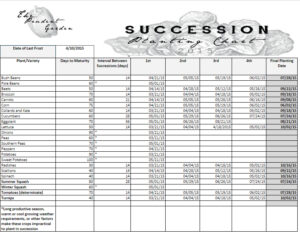Succession gardening, also known as second planting at times, is a garden planning method to gain the most out of limited space and have harvest available for a longer period of time of several different types of crops. This often means planting plants at different times, in pairs to encourage growth, and picking varieties with different maturing rates. Succession gardening has been a long time practice for those who live in the hardiness zones 7 thru 10 aka the south, but there are many options that Alaskans can look at to get the most out of their limited growing time. A book that goes further into the dynamics of this style of gardening is The Winter Harvest Handbook by Eliot Coleman growing in a hardiness zone of 5 in Maine and while some of the time periods might need to be shifted some he recommends Midsummer as the time for zone 4 to 6 gardeners to begin a second planting season. Crops including broccoli, lettuce, peas, spinach, kale, cilantro and arugula can be planted in July and early August for harvest from September through November. The four main techniques for using this growing method are:
- Pull Some, Plant Some. As soon as plants — such as lettuce, spinach and peas — have passed their prime, pull them out and replant. Use every square foot — even little spaces where a cucumber plant expired or the cilantro went to seed. Put the old plants into your compost pile, then aerate the soil and replenish nutrients by forking in some compost and granular organic fertilizer.
- Screen the Sun. When planting in the heat of summer, it’s important to keep the soil surface consistently moist. If it dries out, newly sprouted seeds may die and you will need to start over. As a general rule, seeds planted outdoors in late summer should be sown twice as deep as in the spring. Also, most cool-weather plants will not germinate well if soil temperatures rise over 80 degrees F. Shade netting or the natural shade from a trellis or tall plant can be used to create a relatively cool location for seeding a second crop. Some gardeners find it’s easiest to start fall crops indoors under grow lights or in a greenhouse.
- Sow the Right Crops. Plants that thrive in cool weather include: lettuce, spinach and arugula, carrots, beets, broccoli, Swiss chard, kale and all kinds of Asian greens. Choose disease-resistant varieties that mature quickly. If planting a late-season crop of peas, choose bush peas rather than traditional climbers, as they mature more quickly.
- Don’t Delay. Summer-planted crops typically require longer to mature than spring-planted crops (shorter days and cooler air temperatures slow plant growth). Using the days-to-maturity figure on the seed packet, add an extra 14-days as a “low-light factor”. This will give you your summer planting date. When cold weather arrives, protect plants from frost and cold by covering them with garden fabric or using a cold frame.
If you are interested in planning out a succession garden, many seed companies have charts to help you plan out the times for seeds and what varieties to use. Keep in mind though most of these have been built for warmer hardiness zones and you might need to calculate some changes for the planting dates.





Comments are closed